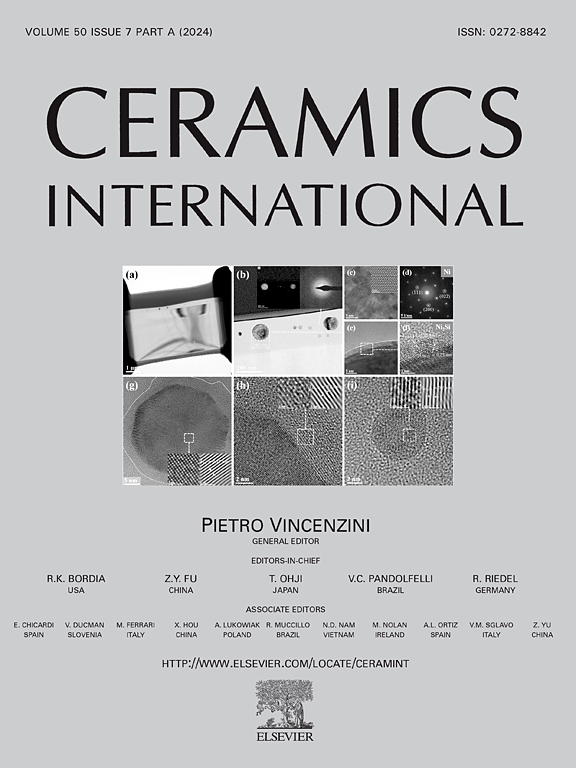Interface characteristics and their effects on the heat transfer behavior and mechanical properties of CVD diamond/Cu brazed joint
IF 5.1
2区 材料科学
Q1 MATERIALS SCIENCE, CERAMICS
引用次数: 0
Abstract
The thermal conductivity and mechanical properties of CVD diamond/Cu joint have always been the focus of attention in the preparation of diamond microwave windows. In this study, a CVD diamond/Cu joint with excellent thermal conductivity of 539 W/m·K and shear strength of 238 MPa was prepared by using Ag-Cu-In-Ti braze interlayer. The evolution of interface characteristics and heat transfer mechanism of joint were studied in detail. The results showed that the diamond interfacial thermal conductivity is greatly enhanced by the continuous nano TiC interlayer. Meanwhile, by adjusting the brazing temperature to eliminate the seam defects and obtain the appropriate width of seam and diffusion zone, it is also helpful to improve the joint performance. The high temperature performance of joint was also characterized, the thermal conductivity and shear strength of joint remained at 499 W/m∙K and 160 MPa respectively at 400 °C. The research is expected to provide reference for the preparation of diamond/metal joints with high thermal conductivity and bonding strength.
界面特性及其对CVD金刚石/Cu钎焊接头传热行为和力学性能的影响
CVD金刚石/Cu接头的导热性能和力学性能一直是金刚石微波窗制备中的研究热点。本研究采用Ag-Cu-In-Ti钎焊中间层制备了导热系数为539 W/m·K、抗剪强度为238 MPa的CVD金刚石/Cu接头。详细研究了接头界面特性的演变过程和传热机理。结果表明,连续的纳米TiC夹层大大提高了金刚石的界面导热性。同时,通过调整钎焊温度消除焊缝缺陷,获得合适的焊缝宽度和扩散区,也有助于提高接头性能。接头的高温性能也得到了表征,在400℃时,接头的导热系数和抗剪强度分别保持在499 W/m∙K和160 MPa。该研究有望为制备具有高导热性和结合强度的金刚石/金属接头提供参考。
本文章由计算机程序翻译,如有差异,请以英文原文为准。
求助全文
约1分钟内获得全文
求助全文
来源期刊

Ceramics International
工程技术-材料科学:硅酸盐
CiteScore
9.40
自引率
15.40%
发文量
4558
审稿时长
25 days
期刊介绍:
Ceramics International covers the science of advanced ceramic materials. The journal encourages contributions that demonstrate how an understanding of the basic chemical and physical phenomena may direct materials design and stimulate ideas for new or improved processing techniques, in order to obtain materials with desired structural features and properties.
Ceramics International covers oxide and non-oxide ceramics, functional glasses, glass ceramics, amorphous inorganic non-metallic materials (and their combinations with metal and organic materials), in the form of particulates, dense or porous bodies, thin/thick films and laminated, graded and composite structures. Process related topics such as ceramic-ceramic joints or joining ceramics with dissimilar materials, as well as surface finishing and conditioning are also covered. Besides traditional processing techniques, manufacturing routes of interest include innovative procedures benefiting from externally applied stresses, electromagnetic fields and energetic beams, as well as top-down and self-assembly nanotechnology approaches. In addition, the journal welcomes submissions on bio-inspired and bio-enabled materials designs, experimentally validated multi scale modelling and simulation for materials design, and the use of the most advanced chemical and physical characterization techniques of structure, properties and behaviour.
Technologically relevant low-dimensional systems are a particular focus of Ceramics International. These include 0, 1 and 2-D nanomaterials (also covering CNTs, graphene and related materials, and diamond-like carbons), their nanocomposites, as well as nano-hybrids and hierarchical multifunctional nanostructures that might integrate molecular, biological and electronic components.
 求助内容:
求助内容: 应助结果提醒方式:
应助结果提醒方式:


